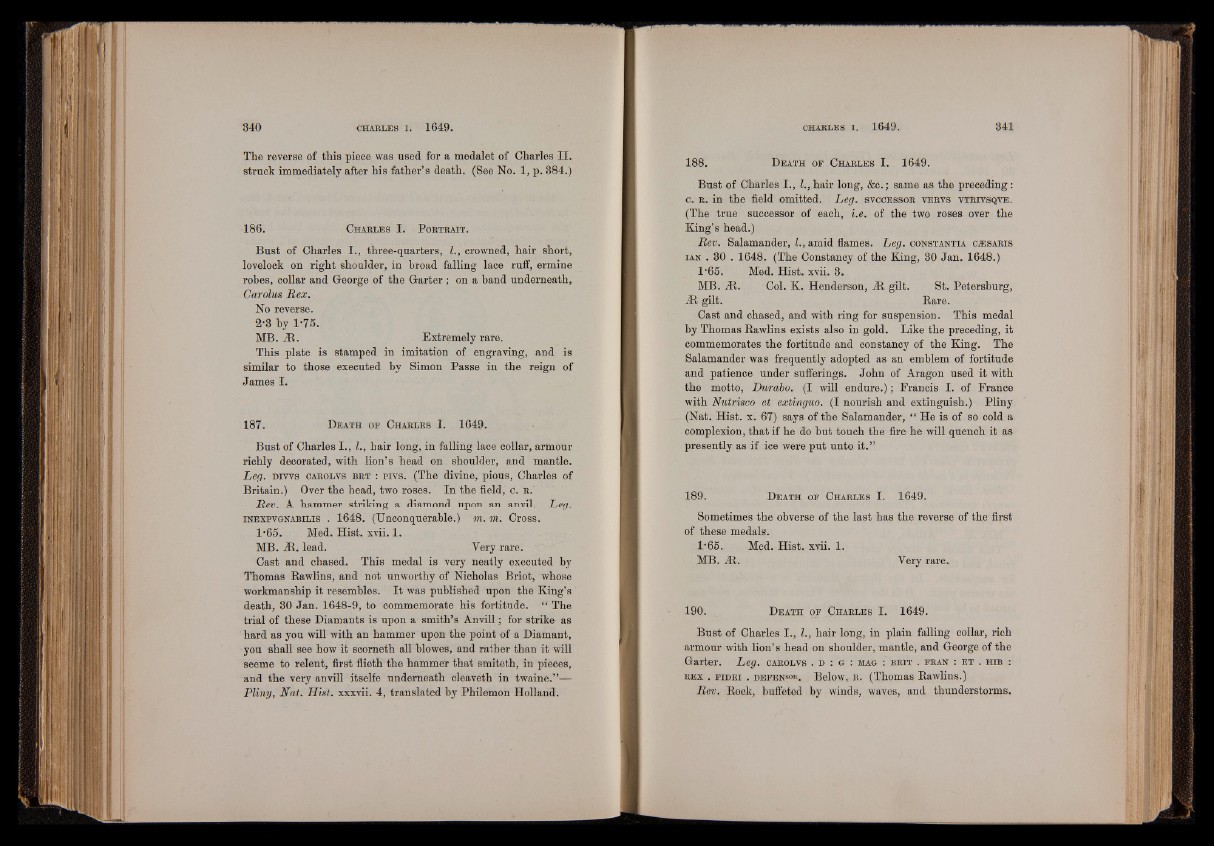
The reverse of this piece was used for a medalet of Charles II.
struck immediately after his father’s death. (See No. 1, p. 884.)
186. C h a r l e s I. P o r t r a it .
Bust of Charles I., three-quarters, I., crowned, hair short,
lovelock on right shoulder, in hroad falling lace ruff, ermine
rohes, collar and George of the Garter; on a hand underneath,
Carolus Rex.
No reverse.
2-3 by 1-75.
MB. jit. Extremely rare.
This plate is stamped in imitation of engraving, and is
similar to those executed hv Simon Passe in the reign of
James I.
187. D e a t h o f C h a r l e s I. 1649.
Bust of Charles I., L, hair long, in falling lace collar, armour
richly decorated, with lion’s head on shoulder, and mantle.
Leg. raws carolvs b r t : pivs. (The divine, pious, Charles of
Britain.) Over the head, two roses. In the field, c. r .
Rev. A hammer striking a diamond upon an anvil. Leg.
in e x p v g n a b il is . 1648. (Unconquerable.) m. m. Cross.
1*65. Med. Hist. xvii. 1.
MB. At. lead. Very rare.
Cast and chased. This medal is very neatly executed by
Thomas Rawlins, and not unworthy of Nicholas Briot, whose
workmanship it resembles. It was published upon the King’s
death, 30 Jan. 1648-9, to commemorate his fortitude. “ The
trial of these Diamants is upon a smith’s Anvill; for strike as
hard as you will with an hammer upon the point of a Diamant,
you shall see how it scorneth all blowes, and rather than it will
seeme to relent, first flieth the hammer that smiteth, in pieces,
and the very anvill itselfe underneath cleaveth in twaine.”—
Pliny, Nat. Hist, xxxvii. 4, translated by Philemon Holland.
Bust of Charles I., I., hair long, &c.; same as the preceding:
c. r . in the field omitted. Leg. sv c c e s sor v er v s vtrtvsqve.
(The true successor of each, i.e. of the two roses over the
King’s head.)
Rev. Salamander, I., amid flames. Leg. constantia Cje sa r is
ia n . 30 . 1648. (The Constancy of the King, 30 Jan. 1648.)
1*65. Med. Hist. xvii. 3.
MB. At. Col. K. Henderson, At gilt. St. Petersburg,
At gilt. Rare.
Cast and chased, and with ring for suspension. This medal
by Thomas Rawlins exists also in gold. Like the preceding, it
commemorates the fortitude and constancy of the King. The
Salamander was frequently adopted as an emblem of fortitude
and patience under sufferings. John of Aragon used it with
the motto, Durabo. (I will endure.); Francis I. of France
with Nutrisco et extinguo. (I nourish and extinguish.) Pliny
(Nat. Hist. x. 67) says of the Salamander, “ He is of so cold a
complexion, that if he do but touch the fire he will quench it as
presently as if ice were put unto it.”
189. D e a t h o f C h a r l e s I. 1649.
Sometimes the obverse of the last has the reverse of the first
of these medals.
1*65. Med. Hist. xvii. 1.
MB. At. Very rare..
190. D e a t h o f C h a r l e s I. 1649.
Bust of Charles I., I., hair long, in plain falling collar, rich
armour with lion’s head on shoulder, mantle, and George of the
Garter. Leg. carolvs . d : g : mag : b r it . fr a n : e t . h ib :
r e x . f id e i . defensok. Below, r . (Thomas Rawlins.)
Rev. Rock, buffeted by winds, waves, and thunderstorms.